Philipp Spitzer
Honey, I Shrunk the Language Model: Impact of Knowledge Distillation Methods on Performance and Explainability
Apr 22, 2025Abstract:Artificial Intelligence (AI) has increasingly influenced modern society, recently in particular through significant advancements in Large Language Models (LLMs). However, high computational and storage demands of LLMs still limit their deployment in resource-constrained environments. Knowledge distillation addresses this challenge by training a small student model from a larger teacher model. Previous research has introduced several distillation methods for both generating training data and for training the student model. Despite their relevance, the effects of state-of-the-art distillation methods on model performance and explainability have not been thoroughly investigated and compared. In this work, we enlarge the set of available methods by applying critique-revision prompting to distillation for data generation and by synthesizing existing methods for training. For these methods, we provide a systematic comparison based on the widely used Commonsense Question-Answering (CQA) dataset. While we measure performance via student model accuracy, we employ a human-grounded study to evaluate explainability. We contribute new distillation methods and their comparison in terms of both performance and explainability. This should further advance the distillation of small language models and, thus, contribute to broader applicability and faster diffusion of LLM technology.
From Consumption to Collaboration: Measuring Interaction Patterns to Augment Human Cognition in Open-Ended Tasks
Apr 03, 2025Abstract:The rise of Generative AI, and Large Language Models (LLMs) in particular, is fundamentally changing cognitive processes in knowledge work, raising critical questions about their impact on human reasoning and problem-solving capabilities. As these AI systems become increasingly integrated into workflows, they offer unprecedented opportunities for augmenting human thinking while simultaneously risking cognitive erosion through passive consumption of generated answers. This tension is particularly pronounced in open-ended tasks, where effective solutions require deep contextualization and integration of domain knowledge. Unlike structured tasks with established metrics, measuring the quality of human-LLM interaction in such open-ended tasks poses significant challenges due to the absence of ground truth and the iterative nature of solution development. To address this, we present a framework that analyzes interaction patterns along two dimensions: cognitive activity mode (exploration vs. exploitation) and cognitive engagement mode (constructive vs. detrimental). This framework provides systematic measurements to evaluate when LLMs are effective tools for thought rather than substitutes for human cognition, advancing theoretical understanding and practical guidance for developing AI systems that protect and augment human cognitive capabilities.
Towards Human-Understandable Multi-Dimensional Concept Discovery
Mar 24, 2025Abstract:Concept-based eXplainable AI (C-XAI) aims to overcome the limitations of traditional saliency maps by converting pixels into human-understandable concepts that are consistent across an entire dataset. A crucial aspect of C-XAI is completeness, which measures how well a set of concepts explains a model's decisions. Among C-XAI methods, Multi-Dimensional Concept Discovery (MCD) effectively improves completeness by breaking down the CNN latent space into distinct and interpretable concept subspaces. However, MCD's explanations can be difficult for humans to understand, raising concerns about their practical utility. To address this, we propose Human-Understandable Multi-dimensional Concept Discovery (HU-MCD). HU-MCD uses the Segment Anything Model for concept identification and implements a CNN-specific input masking technique to reduce noise introduced by traditional masking methods. These changes to MCD, paired with the completeness relation, enable HU-MCD to enhance concept understandability while maintaining explanation faithfulness. Our experiments, including human subject studies, show that HU-MCD provides more precise and reliable explanations than existing C-XAI methods. The code is available at https://github.com/grobruegge/hu-mcd.
Towards a Problem-Oriented Domain Adaptation Framework for Machine Learning
Jan 08, 2025Abstract:Domain adaptation is a sub-field of machine learning that involves transferring knowledge from a source domain to perform the same task in the target domain. It is a typical challenge in machine learning that arises, e.g., when data is obtained from various sources or when using a data basis that changes over time. Recent advances in the field offer promising methods, but it is still challenging for researchers and practitioners to determine if domain adaptation is suitable for a given problem -- and, subsequently, to select the appropriate approach. This article employs design science research to develop a problem-oriented framework for domain adaptation, which is matured in three evaluation episodes. We describe a framework that distinguishes between five domain adaptation scenarios, provides recommendations for addressing each scenario, and offers guidelines for determining if a problem falls into one of these scenarios. During the multiple evaluation episodes, the framework is tested on artificial and real-world datasets and an experimental study involving 100 participants. The evaluation demonstrates that the framework has the explanatory power to capture any domain adaptation problem effectively. In summary, we provide clear guidance for researchers and practitioners who want to employ domain adaptation but lack in-depth knowledge of the possibilities.
Transferring Domain Knowledge with (X)AI-Based Learning Systems
Jun 03, 2024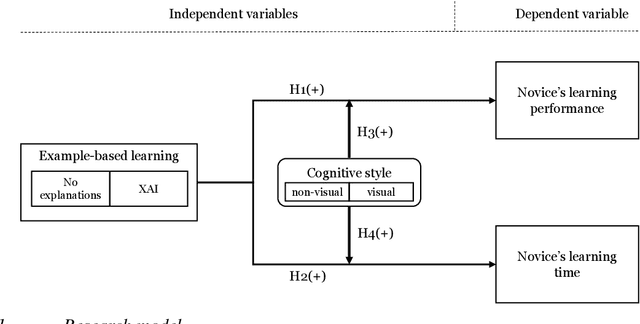
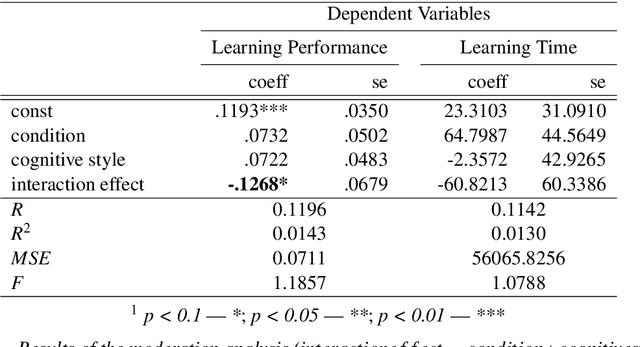

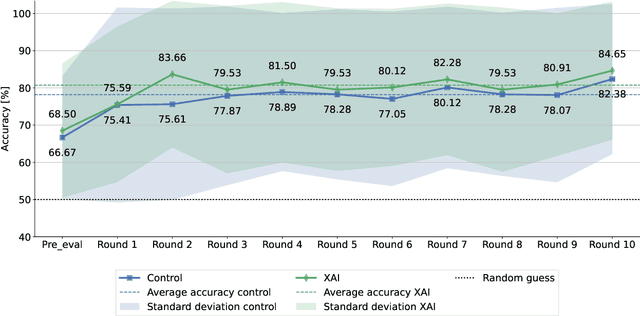
Abstract:In numerous high-stakes domains, training novices via conventional learning systems does not suffice. To impart tacit knowledge, experts' hands-on guidance is imperative. However, training novices by experts is costly and time-consuming, increasing the need for alternatives. Explainable artificial intelligence (XAI) has conventionally been used to make black-box artificial intelligence systems interpretable. In this work, we utilize XAI as an alternative: An (X)AI system is trained on experts' past decisions and is then employed to teach novices by providing examples coupled with explanations. In a study with 249 participants, we measure the effectiveness of such an approach for a classification task. We show that (X)AI-based learning systems are able to induce learning in novices and that their cognitive styles moderate learning. Thus, we take the first steps to reveal the impact of XAI on human learning and point AI developers to future options to tailor the design of (X)AI-based learning systems.
On the Effect of Contextual Information on Human Delegation Behavior in Human-AI collaboration
Jan 09, 2024Abstract:The constantly increasing capabilities of artificial intelligence (AI) open new possibilities for human-AI collaboration. One promising approach to leverage existing complementary capabilities is allowing humans to delegate individual instances to the AI. However, enabling humans to delegate instances effectively requires them to assess both their own and the AI's capabilities in the context of the given task. In this work, we explore the effects of providing contextual information on human decisions to delegate instances to an AI. We find that providing participants with contextual information significantly improves the human-AI team performance. Additionally, we show that the delegation behavior changes significantly when participants receive varying types of contextual information. Overall, this research advances the understanding of human-AI interaction in human delegation and provides actionable insights for designing more effective collaborative systems.
Towards Effective Human-AI Decision-Making: The Role of Human Learning in Appropriate Reliance on AI Advice
Oct 03, 2023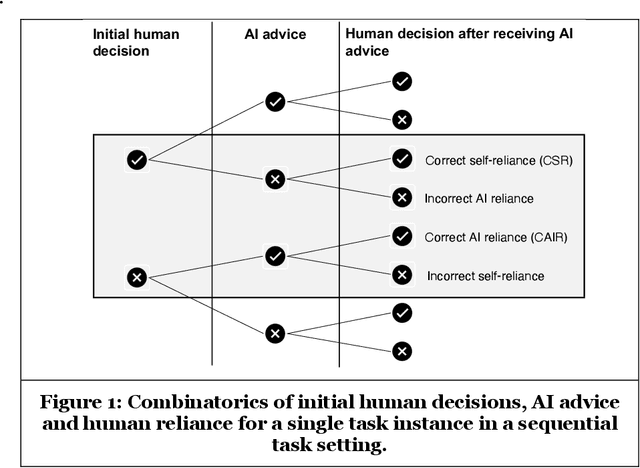

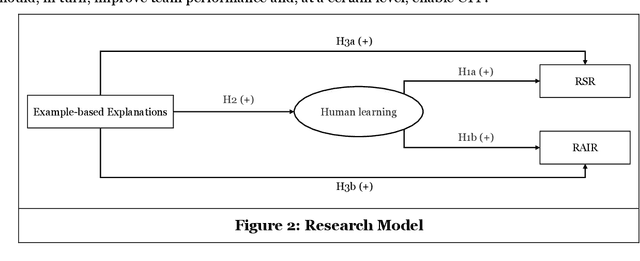

Abstract:The true potential of human-AI collaboration lies in exploiting the complementary capabilities of humans and AI to achieve a joint performance superior to that of the individual AI or human, i.e., to achieve complementary team performance (CTP). To realize this complementarity potential, humans need to exercise discretion in following AI 's advice, i.e., appropriately relying on the AI's advice. While previous work has focused on building a mental model of the AI to assess AI recommendations, recent research has shown that the mental model alone cannot explain appropriate reliance. We hypothesize that, in addition to the mental model, human learning is a key mediator of appropriate reliance and, thus, CTP. In this study, we demonstrate the relationship between learning and appropriate reliance in an experiment with 100 participants. This work provides fundamental concepts for analyzing reliance and derives implications for the effective design of human-AI decision-making.
The Impact of Imperfect XAI on Human-AI Decision-Making
Jul 25, 2023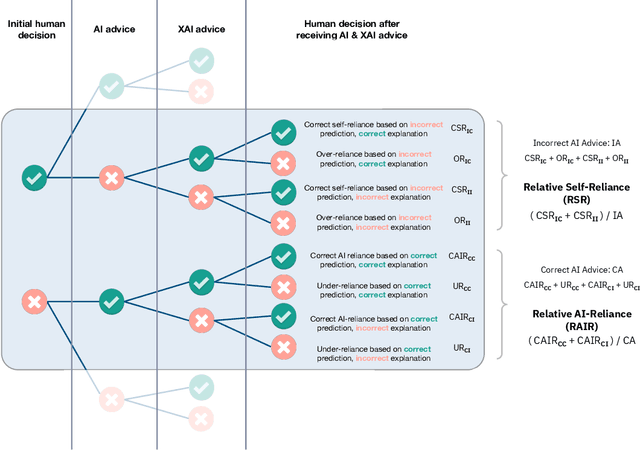
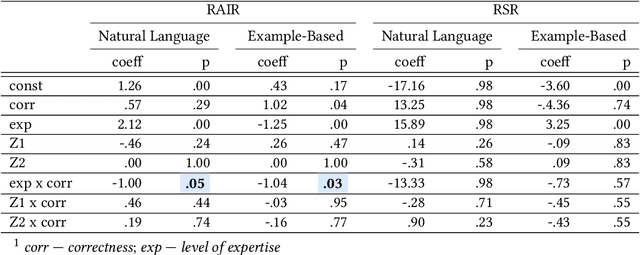
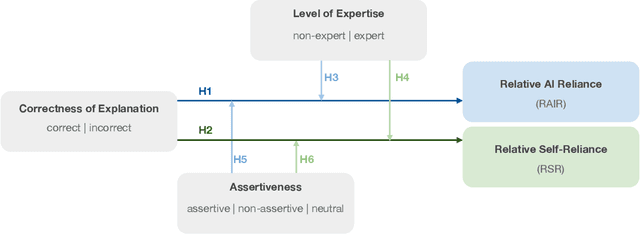
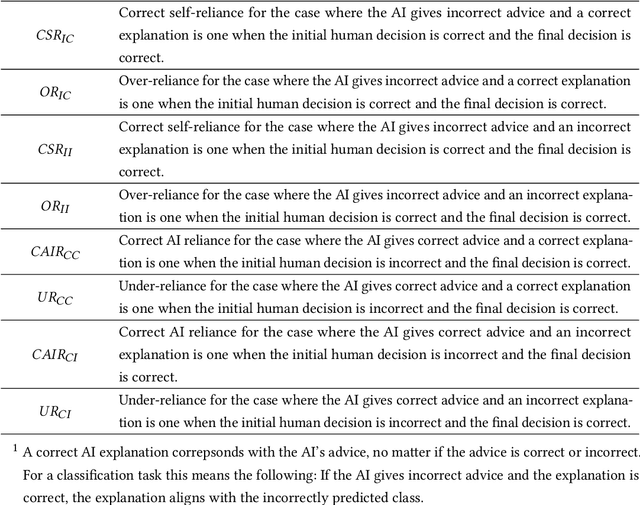
Abstract:Explainability techniques are rapidly being developed to improve human-AI decision-making across various cooperative work settings. Consequently, previous research has evaluated how decision-makers collaborate with imperfect AI by investigating appropriate reliance and task performance with the aim of designing more human-centered computer-supported collaborative tools. Several human-centered explainable AI (XAI) techniques have been proposed in hopes of improving decision-makers' collaboration with AI; however, these techniques are grounded in findings from previous studies that primarily focus on the impact of incorrect AI advice. Few studies acknowledge the possibility for the explanations to be incorrect even if the AI advice is correct. Thus, it is crucial to understand how imperfect XAI affects human-AI decision-making. In this work, we contribute a robust, mixed-methods user study with 136 participants to evaluate how incorrect explanations influence humans' decision-making behavior in a bird species identification task taking into account their level of expertise and an explanation's level of assertiveness. Our findings reveal the influence of imperfect XAI and humans' level of expertise on their reliance on AI and human-AI team performance. We also discuss how explanations can deceive decision-makers during human-AI collaboration. Hence, we shed light on the impacts of imperfect XAI in the field of computer-supported cooperative work and provide guidelines for designers of human-AI collaboration systems.
ML-Based Teaching Systems: A Conceptual Framework
May 12, 2023Abstract:As the shortage of skilled workers continues to be a pressing issue, exacerbated by demographic change, it is becoming a critical challenge for organizations to preserve the knowledge of retiring experts and to pass it on to novices. While this knowledge transfer has traditionally taken place through personal interaction, it lacks scalability and requires significant resources and time. IT-based teaching systems have addressed this scalability issue, but their development is still tedious and time-consuming. In this work, we investigate the potential of machine learning (ML) models to facilitate knowledge transfer in an organizational context, leading to more cost-effective IT-based teaching systems. Through a systematic literature review, we examine key concepts, themes, and dimensions to better understand and design ML-based teaching systems. To do so, we capture and consolidate the capabilities of ML models in IT-based teaching systems, inductively analyze relevant concepts in this context, and determine their interrelationships. We present our findings in the form of a review of the key concepts, themes, and dimensions to understand and inform on ML-based teaching systems. Building on these results, our work contributes to research on computer-supported cooperative work by conceptualizing how ML-based teaching systems can preserve expert knowledge and facilitate its transfer from SMEs to human novices. In this way, we shed light on this emerging subfield of human-computer interaction and serve to build an interdisciplinary research agenda.
On the Perception of Difficulty: Differences between Humans and AI
Apr 19, 2023

Abstract:With the increased adoption of artificial intelligence (AI) in industry and society, effective human-AI interaction systems are becoming increasingly important. A central challenge in the interaction of humans with AI is the estimation of difficulty for human and AI agents for single task instances.These estimations are crucial to evaluate each agent's capabilities and, thus, required to facilitate effective collaboration. So far, research in the field of human-AI interaction estimates the perceived difficulty of humans and AI independently from each other. However, the effective interaction of human and AI agents depends on metrics that accurately reflect each agent's perceived difficulty in achieving valuable outcomes. Research to date has not yet adequately examined the differences in the perceived difficulty of humans and AI. Thus, this work reviews recent research on the perceived difficulty in human-AI interaction and contributing factors to consistently compare each agent's perceived difficulty, e.g., creating the same prerequisites. Furthermore, we present an experimental design to thoroughly examine the perceived difficulty of both agents and contribute to a better understanding of the design of such systems.
 Add to Chrome
Add to Chrome Add to Firefox
Add to Firefox Add to Edge
Add to Edge